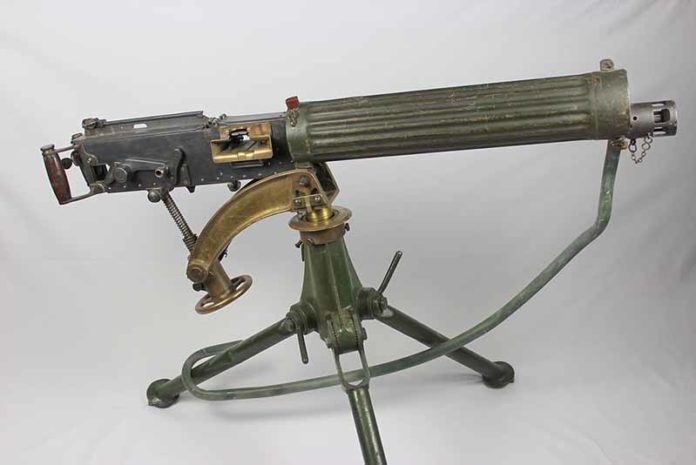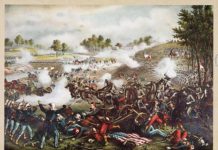
In the final weeks of World War I, the American 123rd Machine Gun Battalion helped defeat the stubborn German forces in the Meuse-Argonne Valley.
On September 26, 1918, the 123rd Machine Gun Battalion, a member of the 65th Infantry Brigade of the 33rd Infantry Division (Prairie Division), broke camp at Boisla Ville, France. Commanded by Major Albert L. Culbertson, the four companies (A, B, C, and D) of the 123rd started to haul their Vickers machine guns for an operation designed primarily to cut the Antwerp-Metz Railroad west of Verdun, over which German soldiers and supplies had moved for four years- the Meuse-Argonne Offensive.
Bois de la Cote Lemont
The 123rd moved from village to village as the Allies experienced modest success in the first days of the offensive. On September 29, the 65 Infantry Brigade was ordered to relieve the 80th Division, with elements of the 123rd taking over positions at Bois de Dannevaux and Bois de la Cote Lemont. By October 1, however, German resistance stiffened as the Argonne Valley provided excellent defensive positions with its thick forest on one side and the Meuse River on the other.
That resistance was experienced first-hand by the 123rd for the next week. They endured heavy shelling, including mustard and sneezing gas shells detonating in the vicinity. German aircraft added to the threat. On October 3, two companies of the 123rd were ordered to Bois de la Cote Lemont to provide a protective fire for the advancing 4th Division’s right flank and to break-up counterattacks.
Teams of 6-8 men lugged the 30 lb guns, 50 lb tripods, and ammunition boxes with 250 round ammunition belts weighing 22 lbs each into position on a woody rise. For four days, the 123rd employed a harassing fire on nearby Brieulles-sur-Meuse, expending an estimated 750,000 rounds, while being harassed themselves by heavy German shelling and gas attacks. Before being withdrawn, the 123rd suffered 9 killed and 53 wounded.
Consenvoye to Connecticut Subsector
On October 8, General John J. Pershing, Commander of the American Expeditionary Force, ordered a push toward the east side of the Meuse River to disable German artillery in that area. Consequently, the 123rd was gradually redeployed east of the Meuse and stationed south of Consenvoye. Between October 13-16, American forces made progress, capturing Consenvoye, Malbrouk, Cole Dame Marie, and Chatillon. The 123rd dealt with light enemy shelling and gas attacks, but sustained 3 killed and 30 wounded.
After it was relieved by a French division in the Consenvoye sector, the 123rd marched piecemeal, without incident, to Bois Delolime, Bois Bourrus, Sommedieue, and Rupt-en-Woeve. Then finally on October 24 and 25, they arrived near Mouilly in the Connecticut subsector to relieve the 311th Machine Gun Battalion at the mainline of resistance. For the next 11 days there were no operations. The 123rd spent time improving gun emplacements, cleaning up themselves and the equipment, reorganizing gun teams, and training.
The calm was interrupted, at least for Company D, when 65th Infantry Brigade headquarters ordered a raid on Chateau et Fme.d’ Aulnois by two companies of the 130th Infantry, covered by a company from the 123rd. Company D spent the night heaving its equipment into place. At 5:45 AM, November 7, the raid began, with D offering barrage fire on the road, trench, and enemy strongpoint northeast of Chateau et Fme. d’ Aulnois, as well as Pinthville and Riaville. D expended 76,000 rounds of ammunition during the successful raid. By 7:45 AM, the company returned with only one minor casualty.
Marcheville and the Eleventh Hour
By November 8, the tired Germans were unable to form a strong defensive line and were in retreat. German leaders contacted French and Allied Commander Ferdinand Foch about an armistice. On November 9, Company D of the 123rd, again, was ordered to support a raid by the 130th Infantry, this time at Marcheville. The following day, D unleashed 75,000 rounds of barrage fire north of Marcheville and a harassing fire on Riaville. American forces briefly captured Marcheville, but strong German counterattacks force them to retreat to higher ground.
November 11, 4:30 AM, the 65th Infantry Brigade moved forward to occupy the gap between Marcheville and St. Hilaire. In the dim, foggy morning, the 123rd had to tote its heavy implements through marshy ground and barbed wire. By 8:30 AM, probes by the 65th and 66th Infantry Brigades drew enemy fire and the Americans retreated. At about 10 AM, word reached the frontline troops of the 65th that an armistice had been signed and hostilities would end at 11 AM.
In the meantime, the Germans pounded the open plain between Marcheville and St. Hilaire with artillery. Major Culbertson, seeing that his 123rd could be exposed if the covering fog lifted, pulled back his battalion, except for two platoons. In addition to the artillery, a German pilot strafed the frontline with machine-gun fire and a lone German machine gunner on the ground was peppering away for the last six minutes before the eleventh hour. Some of the 123rd must have wondered if peace was really at hand. At 11 AM, the sounds of battle were replaced by silence, then cheers. The war was over.
The 123rd Machine Gun Battalion during the Meuse-Argonne Offensive may not have been the famed “Lost Battalion” or did not include the solo heroics of Sergeant Alvin York, but it still performed vital operations. It provided barrage and harassing fire to cover infantry advances, raids, and retreats that ultimately wore the Germans down.
Sources:
- Hollinshead, Byron, ed, I Wish I’d Been There, New York: Doubleday, 2006 (essay: The Road to Butgneville- November 11, 1918, by Robert Cowley)
- Huidekoper, Frederic Louis, The History of the 33rd Division, A.E.F., Volume 3, Illinois State Historical Library, 1921.







